
Rot around fasteners in the backs of wood gutters - WHY?
What are the causes?
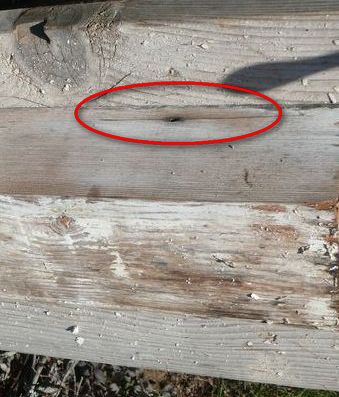
|
The highlighted area in this photo shows a split in the wood caused by the fastener as it was driven through the back of the gutter. This is high up on the back of the gutter and normally would never be sumerged. As long as this gutter never fills to the brim, or water does not run down the back of the gutter, this won't be a problem. However if water enters this split it will be held in there and be extremely difficult to dry out. This is a recipe for rot. Normally water lying in a gutter does not soak all the way through the wood. But splits like this one will suck in the water deep into the wood. The wood gutter back in this photo never rotted because the split area was never under water. A miracle, maybe. Most likely It was the way this gutter was installed that it did not rot. Two choices are available to prevent this, eliminate the fastener splits or the ability for the water to reach the splits. (or do both for added insurance)
| |
For water not to have entered this split a few things had to work perfectly. Namely 1) it drained well so it rarely if ever filled enough for water to reach this split and 2) the roof run off dripped directly into the bottom of the gutter and did not run down its backside over this split. In the photo below that was not the case.
|
|
Look closely and you can see a hole in the back of this gutter every 16" where it was fastened. Water entered deep into the wood through the splits created from the fasteners. I found this gutter with standing water and its small lead leader outlet plugged with mud. The drip edge is also tight to the back of the gutter so roof run-off runs down the back of this gutter. So because the fasteners were not predrilled, the drip edge not properly spaced away from the gutter back and the leaders not large enough to pass the junk the back of this gutter rotted. This type of poor installation is what gives wood gutters a bad reputation. And nothing can match the look of a properly installed wood gutter
|
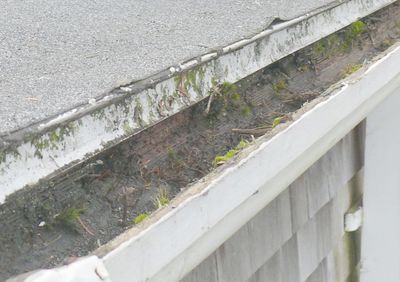
click photo to enlarge
| |
Gutters that rot in back will allow water to get behind them and if they are directly attached to the rafters the soffit and rafter tails will rot too unless the proper vent is installed to allow this water to freely exit and the enclosed members allowed to air dry. (see the last photo)
|
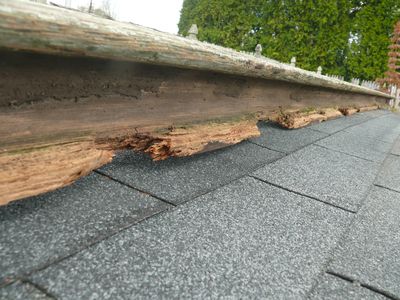
click photo to enlarge
|
Rotted out every 16" on the back only, proof positive that the rot only occurred at the point where water was allowed to enter the wood deeply, namely at the fastener splits. This gutter was spaced away from the fascia with 1/2" wood strips but that did not stop this from happening. I found this first floor gutter under a canopy of trees. It was full of debris and water. The small leader outlets at the very bottom were covered over with tree litter. In this photo the gutter is now dried out. Rotted wood holds water like a sponge, so once rot begins it helps aid further rot by helping the wood in the infected area stay wet longer.
| |
|
|
This is how to prevent a wood gutter from rotting. First eliminate the fastener split by pre-drilling and countersinking the fastener head. Second use corrosion proof fasteners that won't rust away leaving a hole. Third install a wooden drip that will keep the drip apron of the metal dripedge properly spaced away from the fascia/gutter. (see photo on the right) If you can't do that cut the apron off the metal drip edge so the water can't follow it. Fourth install large outlet leaders. Ones who's opening ride up the back or front of the gutter so that it is impossible to completely obstruct them unless the gutter is full to the brim with debris. The way this gutter was installed doomed it to premature failure. I've seen gutters on 100 year old buildings in near perfect condition so wood gutters can and do last a very long time.
|
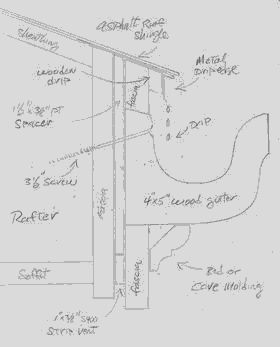
click photo to enlarge
| |
Below is how gutters were installed prior to around 1920's. Soon after that some builders began installing the gutter on top of the fascia board thinking they had a better idea. That trend caught on unfortunately and this changed the aesthetics of the cornice as more of the flat bottom of the gutter was revealed. Another problem this caused was that the roofing was not extended out far enough to get past the thickness of the back of the gutter.
|
|
|
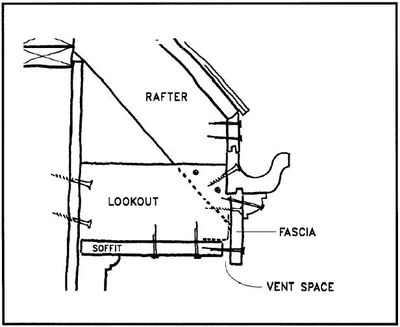
click photo to enlarge
|
Notice in this diagram on the left, that the gutter appears to be only a molding. None of the flat bottom is visible. Also note the "vent" in this diagram where the soffit meets the fascia. If the roof leaks any water the runs downs the rafters or sheathing will exit here. So will ice dam water. The vent allows water to escape and the wood members to air dry. This is a very smart way to head off a future expensive repair if water finds its way into the eaves
|
|

